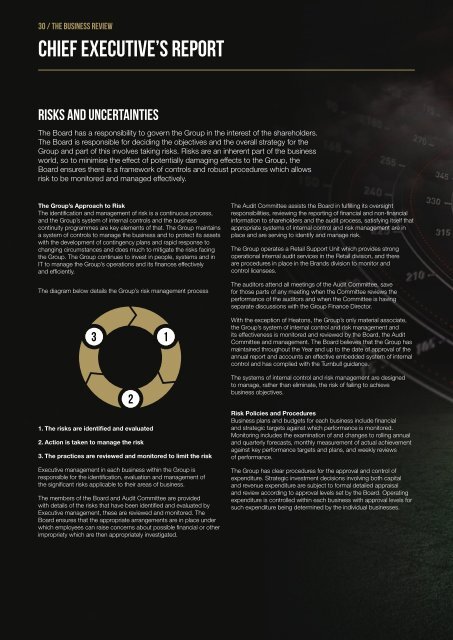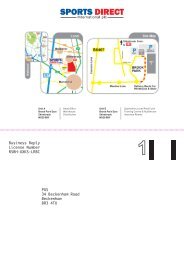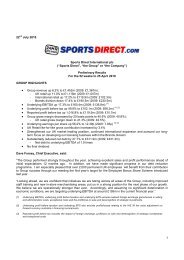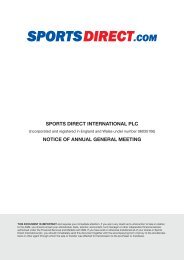Dave Forsey Chief Executive 19 July 2012 - Sports Direct International
Dave Forsey Chief Executive 19 July 2012 - Sports Direct International
Dave Forsey Chief Executive 19 July 2012 - Sports Direct International
You also want an ePaper? Increase the reach of your titles
YUMPU automatically turns print PDFs into web optimized ePapers that Google loves.
30 / THE BUSINESS REVIEW<br />
<strong>Chief</strong> <strong>Executive</strong>’s Report<br />
Risks and uncertainties<br />
The Board has a responsibility to govern the Group in the interest of the shareholders.<br />
The Board is responsible for deciding the objectives and the overall strategy for the<br />
Group and part of this involves taking risks. Risks are an inherent part of the business<br />
world, so to minimise the effect of potentially damaging effects to the Group, the<br />
Board ensures there is a framework of controls and robust procedures which allows<br />
risk to be monitored and managed effectively.<br />
The Group’s Approach to Risk<br />
The identification and management of risk is a continuous process,<br />
and the Group’s system of internal controls and the business<br />
continuity programmes are key elements of that. The Group maintains<br />
a system of controls to manage the business and to protect its assets<br />
with the development of contingency plans and rapid response to<br />
changing circumstances and does much to mitigate the risks facing<br />
the Group. The Group continues to invest in people, systems and in<br />
IT to manage the Group’s operations and its finances effectively<br />
and efficiently.<br />
The diagram below details the Group’s risk management process<br />
1. The risks are identified and evaluated<br />
2. Action is taken to manage the risk<br />
3. The practices are reviewed and monitored to limit the risk<br />
<strong>Executive</strong> management in each business within the Group is<br />
responsible for the identification, evaluation and management of<br />
the significant risks applicable to their areas of business.<br />
The members of the Board and Audit Committee are provided<br />
with details of the risks that have been identified and evaluated by<br />
<strong>Executive</strong> management, these are reviewed and monitored. The<br />
Board ensures that the appropriate arrangements are in place under<br />
which employees can raise concerns about possible financial or other<br />
impropriety which are then appropriately investigated.<br />
The Audit Committee assists the Board in fulfilling its oversight<br />
responsibilities, reviewing the reporting of financial and non-financial<br />
information to shareholders and the audit process, satisfying itself that<br />
appropriate systems of internal control and risk management are in<br />
place and are serving to identify and manage risk.<br />
The Group operates a Retail Support Unit which provides strong<br />
operational internal audit services in the Retail division, and there<br />
are procedures in place in the Brands division to monitor and<br />
control licensees.<br />
The auditors attend all meetings of the Audit Committee, save<br />
for those parts of any meeting when the Committee reviews the<br />
performance of the auditors and when the Committee is having<br />
separate discussions with the Group Finance <strong>Direct</strong>or.<br />
With the exception of Heatons, the Group’s only material associate,<br />
the Group’s system of internal control and risk management and<br />
its effectiveness is monitored and reviewed by the Board, the Audit<br />
Committee and management. The Board believes that the Group has<br />
maintained throughout the Year and up to the date of approval of the<br />
annual report and accounts an effective embedded system of internal<br />
control and has complied with the Turnbull guidance.<br />
The systems of internal control and risk management are designed<br />
to manage, rather than eliminate, the risk of failing to achieve<br />
business objectives.<br />
Risk Policies and Procedures<br />
Business plans and budgets for each business include financial<br />
and strategic targets against which performance is monitored.<br />
Monitoring includes the examination of and changes to rolling annual<br />
and quarterly forecasts, monthly measurement of actual achievement<br />
against key performance targets and plans, and weekly reviews<br />
of performance.<br />
The Group has clear procedures for the approval and control of<br />
expenditure. Strategic investment decisions involving both capital<br />
and revenue expenditure are subject to formal detailed appraisal<br />
and review according to approval levels set by the Board. Operating<br />
expenditure is controlled within each business with approval levels for<br />
such expenditure being determined by the individual businesses.



![Our ref: [ ] - Sports Direct International](https://img.yumpu.com/19248141/1/184x260/our-ref-sports-direct-international.jpg?quality=85)





![Our ref: [ ] - Sports Direct International](https://img.yumpu.com/18440214/1/184x260/our-ref-sports-direct-international.jpg?quality=85)

